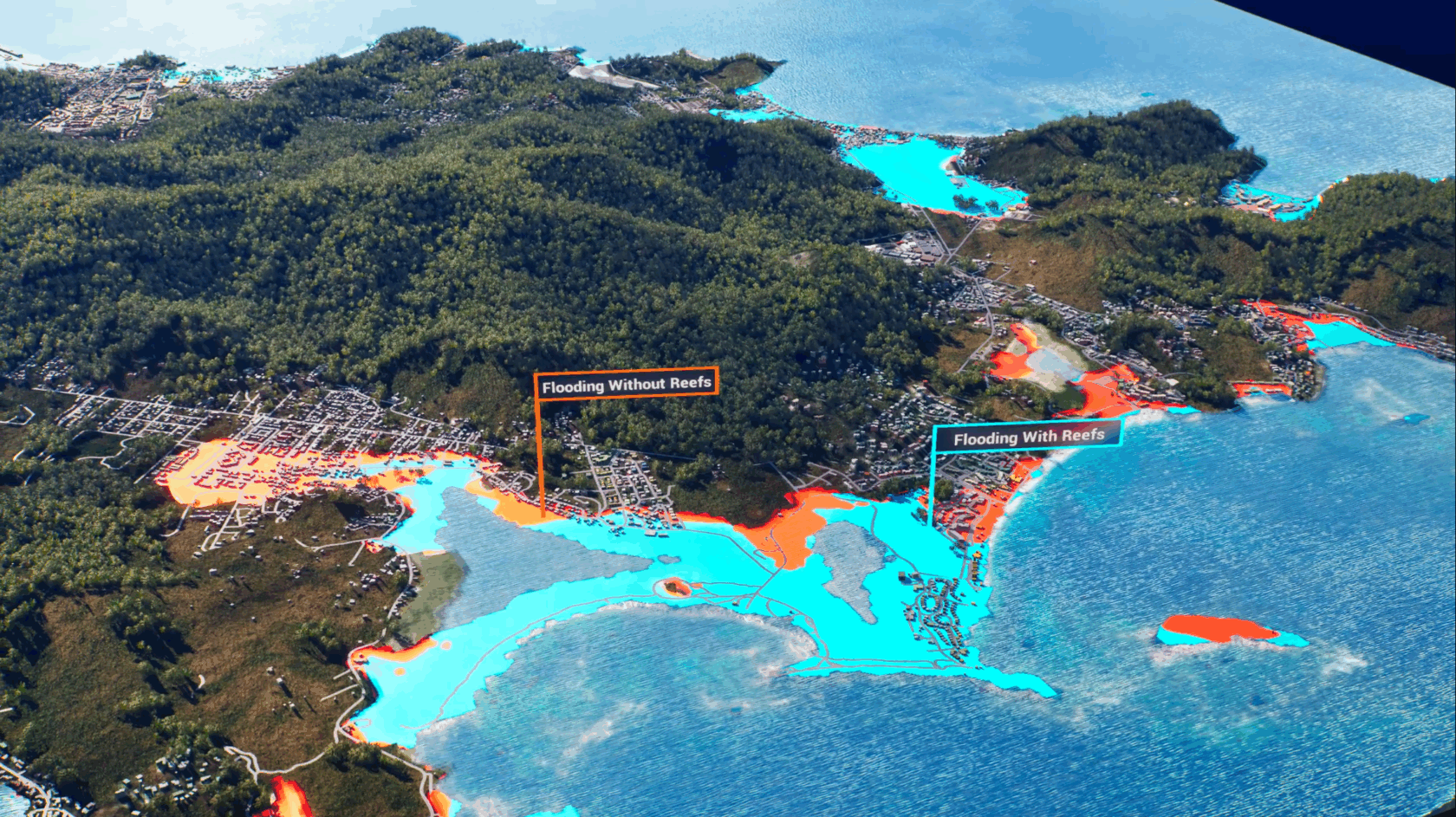Coastal communities within the U.S. have a 26% probability of flooding inside a 30-year interval. This share is anticipated to extend as a result of climate-change-driven sea-level rise, making these areas much more weak.
Michael Beck, professor and director of the UC Santa Cruz Heart for Coastal Local weather Resilience, focuses on modeling and mapping the advantages of coral reefs and mangroves for decreasing flood threat, which helps inform adaptation and preservation efforts.
Beck and his staff produce detailed, NVIDIA GPU-accelerated visualizations of coastal flooding to assist authorities businesses, nongovernmental organizations and monetary organizations higher perceive flood dangers and exhibit how nature-based options can mitigate damages on shore.
“We view visualizations as elementary to motivating motion,” stated Beck. “These are troublesome issues revolving round individuals, a few of them costly to repair, so that you’ve acquired to have the ability to visualize the options and guarantee they’re going to work.”
To speed up the simulations, the middle makes use of NVIDIA CUDA-X software program, together with the cuPyNumeric library and nvfortran compiler, working on NVIDIA RTX GPUs awarded via the NVIDIA Tutorial Grant Program.
Accelerating Flood Mapping With NVIDIA GPUs
Flood modeling begins with a query resembling, “What would occur to Santa Cruz, California, within the occasion of a 100-year storm?”

To reply that query, the analysis staff makes use of simulation instruments resembling SFINCS and feeds the outcomes into the Unreal Engine 5 rendering engine to supply data-driven movies displaying varied flooding eventualities.
Beck’s staff accelerated their flood threat fashions and visualizations from a course of that initially took roughly six hours on CPU workloads to only about 40 minutes utilizing a single NVIDIA RTX 6000 Ada Era GPU. With the staff’s cluster of 4 GPUs, they’ll now run 4 simulations concurrently.
“We have been in a position to cut back the computation by 3-4x, with some workloads being even sooner,” stated David Gutiérrez, senior coastal modeler at UC Santa Cruz’s Heart for Coastal Local weather Resilience. “This speedup gave us the capability to run a sensitivity evaluation beforehand and ensure we’re not making any assumptions or setting the incorrect parameters.”
Much less time spent on modeling and visualizing every website meant the researchers might set extra bold, world targets for his or her challenge.
Digital Flood Mapping Goes World
The staff’s present endeavor is to map all small-island growing states globally — from Tonga to Trinidad and Tobago — earlier than the COP30 local weather change convention in November.

“The type of high-resolution modeling that we’re doing may be very difficult,” Beck stated. “We’re attempting to indicate not simply climate and the issues that climate creates, however run eventualities with options.”
Put Your Cash The place the Marine Life Is
One technique to encourage coral reef preservation is by insuring them based mostly on their worth as pure infrastructure, able to serving as a line of protection throughout climatic occasions.
That is already changing into a actuality in locations just like the Mesoamerican Barrier Reef in Mexico, south of Cancun on the Mayan Riviera.
By means of his work with The Nature Conservancy, Beck introduced visualizations of reefs within the occasion of a hurricane to events, together with resort house owners alongside the coast, the Mexican authorities and World Financial institution Group.
These teams ended up investing in a parametric insurance coverage coverage to guard the coral reef, which stipulated that if the wind reached over 100 knots, a payout can be triggered to revive the broken reef.
“To encourage motion, it’s a must to perceive and visualize a bit extra in regards to the more and more dangerous storm occasions that we’re dealing with proper now, due to the place they’re growing and the impacts of local weather change,” stated Beck.
Different areas all through the Caribbean and Hawaii are additionally beginning to undertake related insurance policies.
Insurance coverage insurance policies like this assist make sure that funding is obtainable to revive reefs after storms — defending coastal communities in opposition to additional, extra extreme flooding harm.
“You’ve acquired all these coral heads and the waves harm them, so you want to both take them to a nursery or cement them again on the reef,” Beck stated. “Additionally, you want to get all of the trash off that comes again out with the flood from the land — every thing from fishing nets to fridges — that’s the flotsam and jetsam of our life.”
These researchers are actually working towards modeling flooding throughout California’s coastal areas via a challenge known as CoSMoS ADAPT.
The challenge’s major aim is to strengthen the USGS’s Coastal Storm Modeling System (CoSMoS), which is the primary toolkit for quantitative analysis of the cost-effectiveness of the state’s coastal adaptation choices, together with nature-based options.
“CoSMoS predicts what dangers will probably be now and into the long run,” Beck stated. “We’re including the options that can cut back the danger — from dunes to sea partitions and our reefs — and at a wide range of ranges, that is going to demand acceleration and heavy computation.”
Apply for an NVIDIA Tutorial Grant
The NVIDIA Tutorial Grant Program is asking for analysis proposals now via Wednesday, Dec. 31, to advance work in three curiosity areas: generative AI and mannequin improvement, generative AI alignment and inference, and robotics and edge AI. Full-time college members at accredited tutorial establishments are eligible to use.
Study extra in regards to the NVIDIA Tutorial Grant Program.
Principal video above reveals visualization of the info layers utilized in a 2D wave and flood mannequin for evaluation of reef and restoration advantages in Christiansted, a city in Saint Croix, one of many U.S. Virgin Islands.

